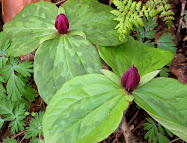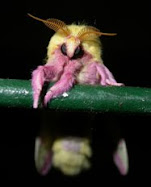At last here are the photos of the moss from the "moss walk" at Cathedral State Park in West Virginia. As I mentioned before I was on two walks with Sue Studler so this is the best photos from both trips. Her enthusiasm was contagious and I hope my photos do her justice because her knowledge of bryophytes is just incredible.
Moss are tiny little plants that are often over looked but once you focus in on them you can see them everywhere. At first I was just enjoying finding them and looking at the diversity. Now I am a little more interested in their names and learning about their life history. Wikipedia said there are 12,000 species world wide and
Annotated Checklist of the Hornworts, Liverworts, and Mosses of West Virginia by Studler, Stephenson and Harmon lists 270 species found in my state so far.
Moss grows on dead trees, live trees, rocks, soil, buildings, concrete, well just about anywhere. Above and below is a little gem called Hypnun imponens (Flat Plait-moss). The leaves reminded me of Native American bead work especially when it sparkled in the sunlight. You can click on all of the photos for closer views.
Hypnun imponens (Flat Plait-moss).
Other than the fact that they are wonderful to look at moss is also important to the ecology. In a cool forest like Cathedral the
Hypnum imponens provides a habitat that is favorable to the establishment of conifer seedlings, such as hemlock and yellow birch.
Hypnun imponens (Flat Plait-moss).
Moss reproduce by means of spores and require water for the whip-like tails of the sperm cell to swim to the female organs for fertilization. It is a fascinating process and I encourage you to look it up and learn more. It is way too complicated to explain in detail on a blog like mine.
Below is a moss that grows on rocks and is called Dicranum fulvum (Boulder Fork-moss)
Close up of Dicranum fulvum (Boulder Fork-moss)
The name refers to the forked peristome teeth. You can read an explanation of peristome on my previous post called
Discovering Moss.
Dicranum montanum (Mountain Fork Moss)
This one is
Dicranum montanum (Mountain Fork Moss) growing on the base of a tree. The
Dicranum family have that windswept curly hair look. The tiny microscopic males are very hard to find among the larger females of this group. Robin Kimmerer in her wonderful book "
Gathering Moss: A Natural and Cultural History of Mosses" says, "When a fertilized female produces spores, those spores are without gender. -- If a spore drifts to a new log that is unoccupied, it will germinate and grow up to be a new full-sized female. But should that spore fall onto a patch of
Dicranum of the same species, it will sift down among the leaves of the existing females and become trapped there, where the female will control its fate. The female emits a flow of hormones which cause that undecided spore to develop into a dwarf male, a captive mate that will become the father of the next generation in the patriarchy." There is certainly more going on in the moss world than meets the eye.
Below is another Dricanum called
Dicranum scoparium (Broom fork moss) and is probably familiar to many of you because it's large size. It was one of the first ones that I learned to identify.
Dicranum scoparium (Broom fork moss)
Close up view of an individual Dicranum scoparium (Broom fork moss)
This next one I found interesting because it grows in the water but it lacks the beauty of the land loving mosses. Fontinalis novae-angliae (New England Water Moss) name refers to springs or "fountains."
Fontinalis novae-angliae (New England Water Moss)
The mats of Fontinalis novae-angliae are an important habitat for stream invertebrates and even a protective site for fish eggs. So even though it looks disgusting it is doing an important job in our streams.
Neckera pennata (Feathery Neckera)
This one seems to spiral around the tree and I believe Sue said that is only grows in old growth forests.
Neckera pennata (Feathery Neckera)
Rhodobryum ontariense (Ontario Rose Moss)
The generic name Rhodobryum translates into the common name, Rose Moss, and refers to the flower-like arrangement of the leaves and the red tinges.
Well, that was a pretty good sampling of the mosses I saw that weekend. I will save the others for another time because they were all so interesting. We saw Sphagnum fimbriatum (Ragged Hair peat moss), Sphagnum palustre (Common Spoon peatmoss), Thuidium delicatulum (Delicate Fern Moss), Ulota Crispa (Cushion Moss), Bartramia pomiformis (Apple Moss), and Leucobryum (White Cushion Moss).
This was a close up view of the outdoors, for the longer view please check out Outdoor Wedensdays.


























+IMG_6552.JPG)
+IMG_7249.JPG)
+IMG_6558.JPG)
+IMG_6878.JPG)
+IMG_6879.JPG)
+IMG_6687.JPG)
+IMG_6577.JPG)
+IMG_6580.JPG)
+IMG_6861.JPG)
+IMG_6858.JPG)
+IMG_6711.JPG)
+IMG_6710.JPG)
+IMG_6571.JPG)






++IMG_6677.JPG)
+IMG_6609.JPG)
+IMG_6612.JPG)
+IMG_6601.JPG)
+IMG_6799.JPG)
+IMG_6800.JPG)





+DSCN5800+for+blog.jpg)



